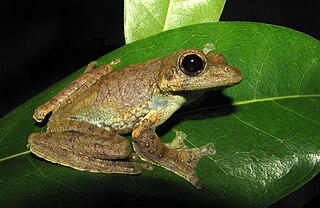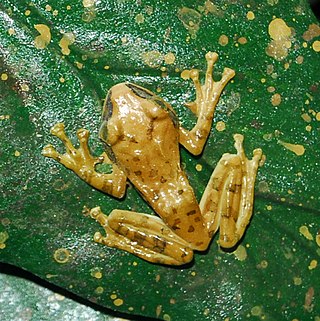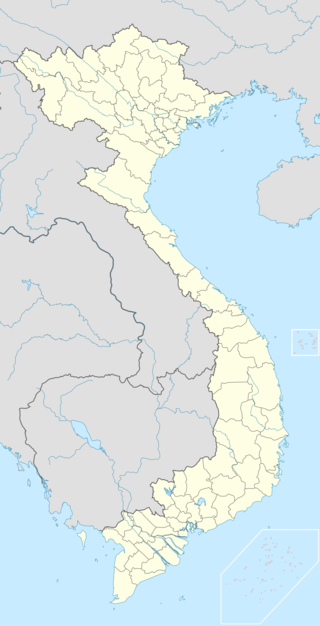
The Rhacophoridae are a family of frogs that occur in tropical sub-Saharan Africa, South India and Sri Lanka, Japan, northeastern India to eastern China and Taiwan, south through the Philippines and Greater Sundas, and Sulawesi. They are commonly known as shrub frogs, or more ambiguously as "moss frogs" or "bush frogs". Some Rhacophoridae are called "tree frogs". Among the most spectacular members of this family are numerous "flying frogs".

Rhacophorus is a genus of frogs in the shrub-frog family Rhacophoridae, which, with the related Hylidae, is one of the two genera of true tree frogs. They are found in China, India, Japan, and throughout Southeast Asia, including the island of Borneo. Over 40 species are currently recognised.

Limnonectes is a genus of fork-tongued frogs of about 75 known species, but new ones are still being described occasionally. They are collectively known as fanged frogs because they tend to have unusually large teeth, which are small or absent in other frogs.

Kaloula baleata, the flower pot toad or sometimes the smooth-fingered narrow-mouthed frog, is a species of narrow-mouthed toad. It is native to India, Borneo, Indochinese Peninsula, Java, Malay Peninsula and Philippines where it lives in lowland rainforests and is tolerant of disturbed sites. The IUCN lists it as being of "Least Concern".

Wallace's flying frog, also known as the gliding frog or the Abah River flying frog, is a moss frog found at least from the Malay Peninsula into western Indonesia, and is present in Borneo and Sumatra. It is named for the biologist, Alfred R. Wallace, who collected the first known specimen.

Polypedates leucomystax is a species in the shrub frog family Rhacophoridae. It is known under numerous common names, including common tree frog, four-lined tree frog, golden tree frog or striped tree frog. Many past authors have united it with the common Indian tree frog in P. maculatus, but today they are generally considered distinct species. In its native range, it is also called "white-lipped tree frog", but this name is otherwise applied to a species of true tree frogs.

Leptomantis angulirostris, commonly known as the masked tree frog, is a member of the tree frog family Rhacophoridae and is found in Indonesia and Malaysian Borneo. Its natural habitats are subtropical or tropical moist lowland forests, subtropical or tropical moist montane forests, and rivers. It is threatened by habitat loss.

The frilled tree frog, rough-armed tree frog, or Southeast Asian tree frog is a species of frog in the family Rhacophoridae found in Brunei, Cambodia, India, Indonesia, Malaysia, Myanmar, the Philippines, Thailand, and Vietnam. Its natural habitats are subtropical or tropical moist lowland forest, subtropical or tropical swamps, subtropical or tropical moist shrubland, rivers, swamps, freshwater marshes, and intermittent freshwater marshes. It is threatened by habitat loss.

Rhacophorus bipunctatus is a frog species in the moss frog family (Rhacophoridae) found from eastern India into Southeast Asia, possibly to southeastern China and south to Malaysia. Due to the identification problems surrounding this species, the eastern and southern limits of its range remain undetermined; all that is known is that the species certainly occurs in the border region of India, Bangladesh, China and Myanmar; its range might extend south to Malaysia, as similar frogs have been reported from Pahang.

Rhacophorus calcadensis, also known as the Kalakad gliding frog, Kalakkad tree frog, and Langbian flying frog, is a species of frog in the family Rhacophoridae endemic to the southern Western Ghats in Kerala and Tamil Nadu states, India. Its name refers to its type locality, the town of Kalakkad in Tamil Nadu.

The blue-spotted tree frog is a species of frog in the family Rhacophoridae. It is found in Indonesia, Malaysia, Singapore, Thailand, and Vietnam, and possibly Brunei and Myanmar.
Leptomantis fasciatus is a species of frog in the family Rhacophoridae found in Malaysia, Indonesia, and Brunei. It has been observed as high as 200 meters above sea level..

Leptomantis harrissoni, common name Harrisson's flying frog or brown tree frog, is a species of frog in the family Rhacophoridae. It is endemic to northern Borneo.

The harlequin tree frog is a species of frog in the family Rhacophoridae found in Brunei, Indonesia, Malaysia, Thailand, and the Philippines. Its natural habitats are subtropical or tropical moist lowland forest, subtropical or tropical moist montane forest, freshwater marshes, and intermittent freshwater marshes. It is threatened by habitat loss.
The Malayan flying frog is a species of frog in the moss frog family (Rhacophoridae). It is found in Indonesia, Malaysia, and Thailand.
Leptomantis rufipes is a species of frog in the family Rhacophoridae. It is endemic to Borneo and known from isolated locations in south-central Sarawak and eastern Sabah and central Kalimantan (Indonesia). Common names Malaysian flying frog and red-legged frog have been coined for this species. The specific name rufipes refers to the red webbing of this frog.

Leptomantis, known as slim treefrogs, is a genus of frogs found from southern peninsular Thailand to the Philippines. Species in the genus Leptomantis were formerly considered part of the genus Rhacophorus.

Vampyrius vampyrus is a medium-sized species of flying frogs endemic to Vietnam. It is found in southern Vietnam, and is not known to be found in other places globally. It Is in the kingdom Animalia, phylum Chordata, and class Amphibia. Along with this, it is in the order Anura, family Rhacophoridae, and it is the only member of the genus Vampyrus. It is also known as the vampire tree frog or the vampire flying frog because of the presence of a pair of fang-like hooks in the mouth of the tadpoles.
Leptomantis belalongensis is a species of frog in the family Rhacophoridae. It is endemic to Brunei and Malaysia.
Leptomantis gadingensis, the Gunung Gading tree frog or Gading tree frog, is a species of frog in the family Rhacophoridae. It is endemic to Malaysia, where it has been observed between 0 and 150 meters above sea level.














